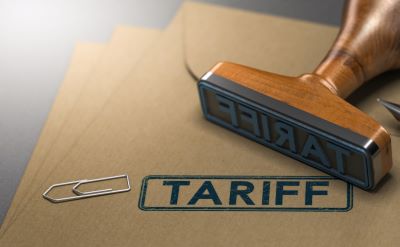
Fitch Ratings’ latest report on the effect of new tariffs announced by President Donald Trump found the trade levels at their highest points in 116 years.
Fitch’s report estimated the baseline 10% tariff and additional reciprocal tariffs on numerous countries will raise the United States’ effective tariff rate (ETR) to about 25%. The rate is the highest in the U.S. since 1909 and is significantly higher than Fitch projected in March. Last month, Fitch projected an 18% ETR for 2025.
Because the ETR is higher, Fitch said its previous projection of 1.7% U.S. growth in 2025 likely will be slower.
“Tariff hikes will result in higher consumer prices and lower corporate profits in the U.S.,” the report said. “Higher prices will squeeze real wages, weighing on consumer spending, while lower profits and policy uncertainty will act as a drag on business investment.”
In addition, Fitch said the upward pressure on goods prices likely means the Federal Reserve will be more cautious about instituting further interest-rate cuts.
Fitch said, “We expect these effects will likely outweigh the benefits U.S. companies might gain from increased protection against foreign competition.”
Fitch said some countries could undergo monetary and fiscal policy easing to offset the tariffs’ effects. Some countries also could negotiate better bilateral trade deals.
“Conversely, the strong possibility of retaliation by key trade partners raises the risk of further escalation,” the report said, “with the U.S. potentially raising tariff rates even further on countries that take retaliatory trade action.”
Retaliation
China responded to the new tariffs on its imports to the U.S. by declaring a 34% tariff on all U.S. goods imported to China. The tariff would take effect April 10, the day after the U.S. raises its tariffs on Chinese imports to 54%.
China’s Finance Ministry said the U.S. tariffs were “inconsistent with international trade rules” and endangered “global economic development and the stability of the production and supply chain.” China also filed a complaint against the U.S. with the World Trade Organization.
Trump replied on social media Friday morning, saying China panicked and did the one thing the country could not afford to do.
Canada is among the countries planning retaliatory tariffs. Prime Minister Mark Carney said his country would match the United States’ 25% tariff on all vehicle imports that are not covered by the U.S-Mexico-Canada Agreement (USMCA). The tariff will apply to non-Canadian content of USMCA-compliant vehicles from the U.S. but would not affect auto parts.
European Commission President Ursula von der Leyen said the European Union also planned retaliatory tariffs, with details yet to be revealed.
Trump on Thursday told reporters on Air Force One that he would be open to tariff negotiations if countries offered him something phenomenal. The statement contradicted earlier reports from Commerce Secretary Howard Lutnick, who said the tariffs were not open to negotiation. Shortly before the president’s statement, top trade aide Peter Navarro said the tariffs are “not a negotiation.”
Reactions
Nissan Motor’s Infiniti brand said it indefinitely paused building two crossover vehicles in Mexico in response to the tariffs. The news came after Stellantis, maker of Chrysler and Fiat automobiles, delayed production in a Canadian assembly plant and a Mexican assembly plant.
The Infiniti brand previously announced the QX50 and QX55 crossover vehicles would cease production at the end of 2025. The plant building the models employs over 3,000 workers.
Canada’s Carney said the Stellantis announcement, which will shut down the company’s Windsor, Ontario, plant for two weeks, would lay off 3,600 workers. He called the U.S. tariffs’ effect “monumental.”
Digesting all the news, stock markets crashed again Friday. Asian markets closed 1.5% to 2.75% lower, European markets were down about 4% through the middle of trading and U.S. markets opened 3% to 4% lower. The Dow Jones Industrial Average was down more than 1,000 points for the second consecutive day. The only time the Dow Jones closed 1,000 points or more lower on consecutive days was March 11 and March 12, 2020.





